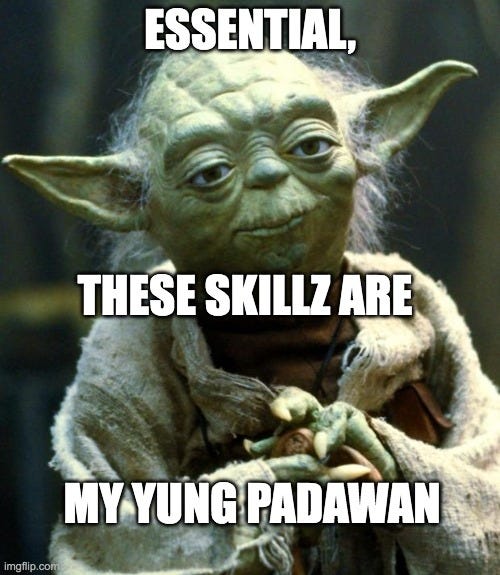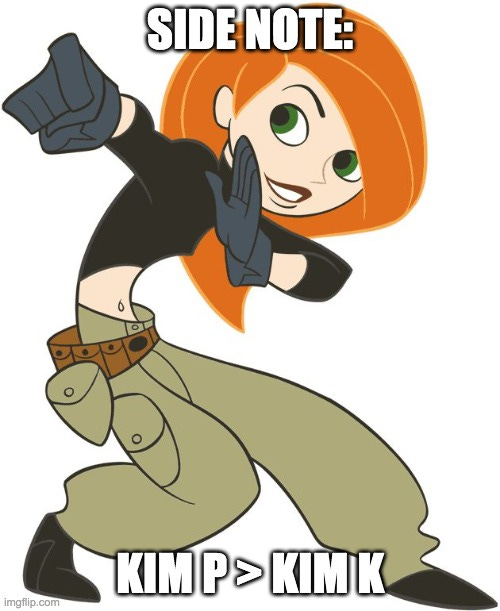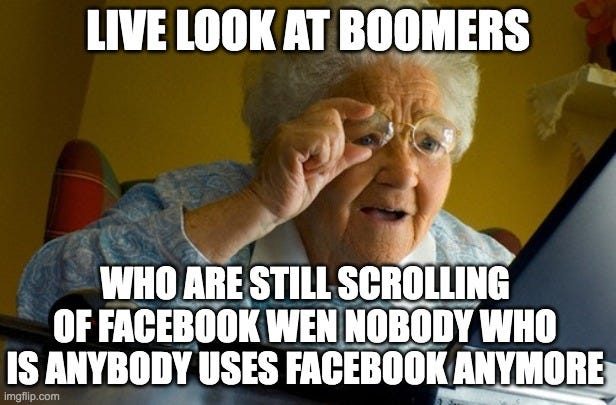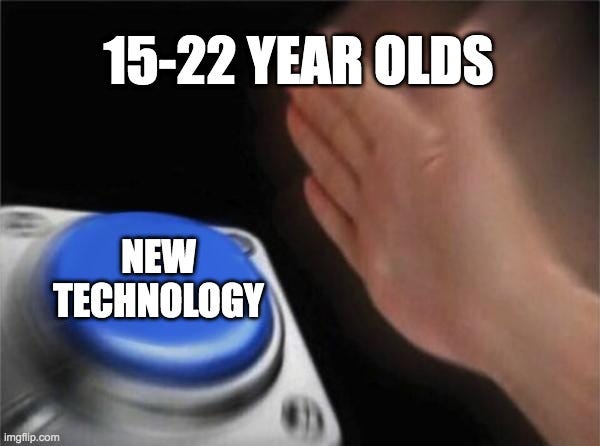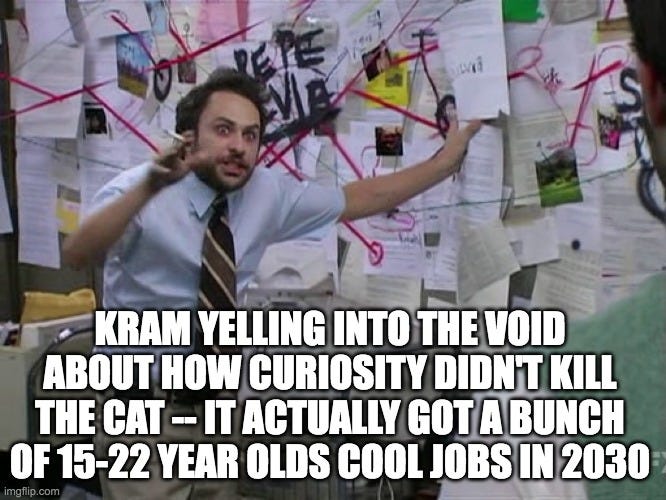The Question
“What skills will be needed in 2030 for people that are currently between the ages of 15-22? And why? And how to get them?”
- Kram the Elder (not the Eldest)
The Answer
In the not-too-distant future (not as far away as a galaxy far, far away as seen in Star Wars, but in 2030), young people aged 15-22 will need a variety of skills for success. From the strategic use of technology to the ability to think critically and problem solve, these skills will be essential for young adults looking to make a mark on the world.
Technology is perhaps the most important skill any young person can acquaint themselves with. By 2030, technology will be even more ubiquitous than it is today and it is thus important to embrace it and use it to one’s advantage. This means that while everyone should be comfortable with the use of technologies like computers, phones, and tablets, they should also be able to use these tools to efficiently complete tasks and research.
Additionally, knowing programming languages, or even just having an understanding of web development and data analytics, will be beneficial for those looking to stand out in the workplace and will be essential for the future of work.
Another key skill for young adults in 2030 is the ability to think critically, solve problems, and think outside of the box. A great way to learn these skills is by playing creative, stimulating games like Minecraft, with the additional benefit of learning STEM skills while doing so.
Creative problem solving is something that can’t be taught in a classroom, and the ability to think up innovative solutions will be incredibly valuable in any profession. Also, showing initiative and adaptability in terms of tasks and projects will be key in any field and in any job. For example, being able to take initiative in game design, graphic illustration, and website coding are invaluable skills that can be taught through creative outlets like video games, art classes, and coding clubs.
While many of the skills needed in 2030 can be taught and shouldn’t be feared, a lot of people are already well-equipped with some essential skills. For example, those born today who will be 22 in the year 2030 already have a natural, intuitive understanding of technology that previous generations don’t have. Also, since many young people today are already so connected with each other through the internet, communication and collaboration skills will become even more important in 2030.
Finally, as the iconic tween superhero Kim Possible said, “anything is possible if you just put your mind to it.” In other words, having a positive attitude and confidence are key skills that so many young people already have and will be incredibly useful in 2030. It’s important to stay motivated and have enthusiasm for whatever project or task is being worked on. Whether it’s coding a website, managing a budget, or caring for a patient, passion and a can-do attitude will be found in those with the best success.
Overall, in order to succeed in 2030, young adults aged 15-22 will need various skills such as a familiarity with technology, creative problem solving, communication and collaboration, confidence, and a positive attitude. It’s important for these skills to be developed early on, as it takes time and practice to master them. By taking advantage of learning opportunities like coding clubs, playing creative games, and having an open mind, these important skills can be acquired and used to reach success in the future.
The Twist
While I agree with many of the points above, I have a confession to make…
I didn’t actually write this essay.
An AI bot called Chat GPT created this essay in 30 seconds after I inserted the following prompt into the Playground on beta.openai.com.
“Write a 1000-word article on the following prompt: What skills will be needed in 2030 for people that are currently between the ages of 15-22? And why? And how to get them? Since this article is lighthearted, use pop culture references throughout to explain why learning certain skills are important.”
If you haven’t heard of OpenAI, then you definitely need to do a deep dive. It is an Elon Musk-founded company aiming to develop and open-source artificial intelligence in ways that can benefit humanity as a whole. So far, OpenAI has launched three groundbreaking technologies:
DALL-E — creates and edits images based on text prompts from users
Codex — translates natural language (so text and ideas) into code
GPT-3 — writes about any googable topic like a human
There are so many cool ways to mess around with this stuff. For my job, I have started using GPT-3 as an editor. I literally go to OpenAI, throw in a paragraph of text and ask GPT-3 to "suggest improvements and highlight any errors found in this document.” I can imagine that this is going to be revolutionary for high school students wanting to figure out a quick way to write an analysis on To Kill a Mockingbird.
It gets even spicier when you combine GPT-3 and DALL-E. For instance, I went and prompted GPT-3 to describe what it thought a University classroom might look like in 2050. For fun, I also directed it to use Dr. Suess-like prose.
GPT-3 didn’t disappoint. It immediately spit out some bars —
So I went and took GPT-3’s idea, headed over to DALL-E, and input the Suessian classroom thesis as an image prompt. Here’s what I got back:
This is AMAZING! Absolutely amazing.
While this specific use-case (generating an image based on the “imagination” of an AI chatbot) might seem frivolous, the ramifications are massive. Humanity just invented a tool that is available and free to anyone on the internet that allows them to create any type of image, text, or program by using descriptive language!
WOAH.
Kram’s Actual Answer To Kram the Elder
So let’s get back to the original question here.
“What skills will be needed in 2030 for people that are currently between the ages of 15-22? And why? And how to get them?”
- Kram the Elder
I believe the number one skill that a 15-22 year old needs to prepare for themselves for 2030 is curiosity.
We are living in the very earliest stage of the internet (it’s been around for 40 years, which is, ummm, half as old as my grandad). 15-22 year olds have a MASSIVE opportunity to be curious and test out technology and get GOOD at that technology before older people even hear about it.
Seriously — to the 15 year olds reading this — go use GPT-3 for writing papers in high school and see if you can get away with it. Don’t do it because you’re lazy and a bad person — do it because it’s interesting AF and because, well, I bet that “prompt generator” for articles is going to be a job in 5 years and if you start writing prompts for AI bots now, then you will be the most qualified person for that job when it is finally created.
Technology is expanding at a rapid, rapid pace and young people need to keep up. The only way to do this is by trying new applications and platforms as often as possible.
As silly as it sounds, becoming a power TikTok user, buying NFTs and messing around with crypto, generating articles and images with OpenAI to, learning how to build a no-code website using Weebly, or getting really, really good at Minecraft are probably the best things a young person can be doing. Practicing with technology leads to becoming a power user, and becoming a power user gets you PAID (ask the boomers who got really good at Excel back in the day for whipping up exquisite macros).
And this is where curiosity becomes so important… because I don’t think young people can count on learning any of this stuff in school.
There are no social media classes in high school, even though creating a following on social media is genuinely a profession that people can and should pursue. Nobody is teaching students when or when not to use emojis when DMing your boss, or how to correctly format a Twitter thread. I can guarantee you nobody is walking into Finance 101 and learning how to send Bitcoin to someone in India. Can you imagine an English teacher being bold enough to allow students to use GPT-3 in a class? Probably not.
Being constantly curious is soooo important and I qualify it as a SKILL. It takes effort to try new things, especially new technology. Moving from Microsoft to G-Suite for things like spreadsheets, word documents, and presentations is really hard to do because it destroys all your shortcuts. Buying a new type of computer is a burden because it breaks up lots of your workflow. Transitioning to a new social media platform means you have to build up a following all over again. Et cetera, et cetera.
However, with a sharp and curious mind, these little roadblocks become challenges instead of obstacles. (Examples: "How fast can I learn to do a VLOOKUP in Google Sheets?” “What types of processing power can I unlock by swapping my Mac for a Lenovo?” “How can I get to 10,000 followers as fast as possible?”)
Conclusion
Curiosity is uber important for young people. Boomers have the money, voting power, houses, and cushy jobs. The only way to catch up with the boomers is to understand technology at such a native level that boomers have to retire early because they can’t keep up anymore with such progress.
And the only way to become a tech-native person is to be curious and, like, actually test out all of the cool stuff being invented.
Anyways.
You should go use GPT-3 right now.
- Kram
note: I asked GPT-3 to describe DALL-E in a way that can be painted. GPT-3 came in clutch with a banger: “A colorful portrait of a quirky robot, surrounded by vibrant blooms of imagination, creating a unique work of art from the depths of its neural network. Its bold red body and long metal limbs turn ideas into reality, as it tirelessly scours through a massive database of knowledge and produces stunning images to share with the world.” I used this input to create the banner image for the article.





